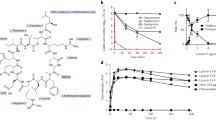Abstract
The peptide HP (2-20), derived from the N-terminal sequence of Helicobacter pylori ribosomal protein L1 (RPL1), has a nematicidal activity against eggs and worms of Caenorhabditis elegans. Eggs treated with HP (2-20) (69%) has a higher fluorescence intensity with propidium iodide staining, which was similar to that of melittin (82%) but higher than untreated cells (5.7%). Confocal microscopy showed that the peptides were located in the shell of the eggs and the inner and outer surfaces of the worms. HP (2-20) therefore may exert its antinematodal activity by disrupting the structure of the egg's shell and the cell membrane via pore formation or by direct interaction with the lipid bilayers in a detergent-like manner.
Similar content being viewed by others
References
Bechinger B, Zasloff M, Opella S (1993) Structure and orientation of the antibiotic peptide magainin in membranes by solid-state nuclear magnetic resonance spectroscopy. Protein Sci. 2: 2077–2084.
Broekaert W, Terras F, Cammue BPA, Osborne R (1995) Plant defensins: novel antimicrobial peptides as components of the host defense system. Plant Physiol. 108: 1353–1358.
Christensen B, Fink J, Merrifield RB, Mauzerall D (1988) Channelforming properties of cecropins and related model compounds incorporated into planar lipid membranes. Proc. Natl. Acad. Sci. USA 85: 5072–5076.
Dempsey CE (1990) The actions of melittin on membranes. Biochim. Biophys. Acta 1031: 143–161.
Ganz T, Lehrer RI (1994) Defensins. Curr. Opin. Immunol. 6: 584–589.
Hoffmann JA (1995) Innate immunity of insects. Curr. Opin. Immunol. 7: 4–10.
Kurz CL, Ewbank JJ (2003) Caenorhabditis elegans: an emerging genetic model for the study of innate immunity. Nat. Rev. Genet. 4: 380–390.
Lee DG, Park J-H, Shin SY, Lee SG, Lee MK, Kim KL, Hahm K-S (1997) Design of novel analogue peptides with potent fungicidal but low hemolytic activity based on the cecropin A-melittin hybrid structure. Biochem. Mol. Biol. Int. 3: 489–498.
Lee DG, Park Y, Kim HN, Kim HK, Kim PI, Choi BH, Hahm K-S (2002) Antifungal mechanism of an antimicrobial peptide, HP (2-20), derived from N-terminus of Helicobacter pylori ribosomal protein L1 against Candida albicans. Biochem. Biophys. Res. Commun. 291: 1006–1013.
Lehrer R, Lichtenstein AK, Ganz T (1993) Defensins: antimicrobial and cytotoxic peptides of mammalian cells. Annu. Rev. Immunol. 11: 105–128.
Maggenti AR (1981) In: General Nematology. New York: Springer-Verlag pp. 372–410.
Mangoni ME, Aumelas A, Chamet P, Roumestand C, Chiche L, Despaux E, Grassy G, Calas B, Chavanieu A (1996) Change in membrane permeability induced by protegrin 1: implication of disulphide bridges for pore formation. FEBS Lett. 383: 93–98.
Merrifield RB (1986) Solid phase synthesis. Science 232: 341–347.
Peixoto CA, Souza WD (1995) Freeze-fracture and deep-etched view of the cuticle of Caenorhabditis elegans. Tissue Cell 27: 561–568.
Putsep K, Branden CI, Boman HG, Normarks S (1999) Antibacterial peptide from H. pylori. Nature 398: 671–672.
Rappleye CA, Paredez AR, Simth CW, McDonald KL (1999) The coronin-like protein POD-1 is required for anterior-posterior axis formation and cellular architecture in the nematode Caenorhabditis elegans. Genes Develop. 13: 2838–2851.
Rodriguez-Kabana R, Canullo GH (1992) Cropping systems for the management of phytonematodes. Phytoparasitica 20: 211–224.
Steiner H, Andreu D, Merrifield RB (1988) Binding and action of cecropin and cecropin analogues: antibacterial peptides from insects. Biochim, Biophys. Acta 939: 260–266.
Wharton DA, Jenkins T (1978) Structure and chemistry of the eggshell of a nematode (Trichuris suis). Tissue Cell 10: 427–440.
Author information
Authors and Affiliations
Rights and permissions
About this article
Cite this article
Jang, SH., Park, Y., Park, SC. et al. Antinematodal activity and the mechanism of the antimicrobial peptide, HP (2-20), against Caenorhabditis elegans . Biotechnology Letters 26, 287–291 (2004). https://doi.org/10.1023/B:BILE.0000015427.26410.d4
Issue Date:
DOI: https://doi.org/10.1023/B:BILE.0000015427.26410.d4




